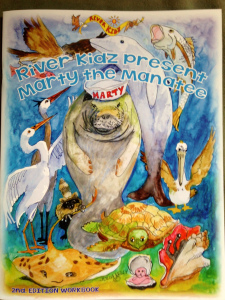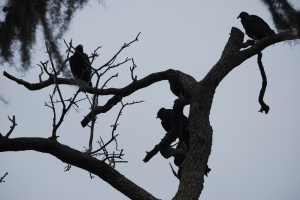A few weeks ago I put out a call for books that people thought would be good for our Florida Legislators to read. I got a great response. Thank you all so much. I put up my poll. Thank you from the bottom of my heart for the 27 people who cared and took the time to vote.
I’ve done this before. Sent books that I thought was important. Not just to politicians but to friends. I think I have bought at least 50 copies of my favorite book “The Art of Racing in the Rain.”
I can tell you that people from both sides that have never read “The Swamp.” Many have not even heard “Paving Paradise.” Most can’t be bothered. They just don’t want to hear about it.
Our elected officials need to be bothered. They need to read.
If you don’t have time put it in your bathroom and read a little everyday.
Why? Because reading matters. It really does.
“New technology allows us to see the living brain at work. Reading can help unlock remarkable powers. Reading builds new connections in the brain which in turn helps to create stepping stones to understand other people’s worlds.
A good book literally has the power to change you.”
We should be asking the candidates what was the last five books they read. Take note question askers.
I forgot one book and I apologize to fellow WordPress blogger and future Martin County Commissioner Jacqui Thurlow-Lippisch. I totally forgot The RiverKids Workbook. Yikes. So I’m adding it in. Because like me you guys forgot also.
Here is the new poll in order :
Here is each book :
Paving Paradise:Florida’s Vanishing Wetlands and the Failure of No Net Loss.
Authors: Craig Pittman and Matthew Waite
“In an award-winning newspaper series, two investigative reporters from the St. Petersburg Times chronicled how federal rules meant to protect the nation’s wetlands were more illusion than law. Now, that series has been expanded into a book, delving into how we got to this point, starting with land speculators making waterfront property out of sand dredged from the bottom of the ocean. Now, read how the nation’s wetlands protections were formed in clashes between developers, bureaucrats, judges, activists and con artists over Florida swamps.”
This is an exhaustive, timely and devastating account of the destruction of Florida’s wetlands, and the disgraceful collusion of government at all levels. It’s an important book that should be read by every voter, every taxpayer, every parent, every Floridian who cares about saving what’s left of this precious place.” — Carl Hiaasen
I am amazed, horrified and delighted that you wrote Paving Paradise! You have uncovered the perfidy that we always knew existed … You have named the key figures that led to the loss of thousands of acres of Florida wetlands.” —Nathaniel Reed
The Everglades: River of Grass Marjory Stoneman Douglas
“The Everglades: River of Grass is a non-fiction book written by Marjory Stoneman Douglas in 1947. Published the same year as the formal opening of Everglades National Park, the book was a call to attention about the degrading quality of life in the Everglades and remains an influential book on nature conservation as well as a reference for information on South Florida.
Douglas was a freelance writer who submitted stories to magazines throughout the 1920s, ’30s and ’40s. Her friend Hervey Allen was an editor at Rinehart, responsible for the Rivers of America Series. Allen asked her to write a story about the Miami River, but Douglas did not find it very interesting, calling it only “an inch long”. She began learning more about the Miami River though, and in her research, she instead suggested to her editor to write a story about the Everglades. Douglas spent five years researching the Everglades, consulting with Garald Parker of the US Geological Survey, who was studying the Everglades hydrology systems, and eventually wrote nearly 40 papers on the ecosystems in the Everglades.
The Quarterly Review of Biology reviewed the book and commented on Douglas’ “convincing evidence” in her assertion that the Everglades are a river instead of a swamp, and declared that “it is hoped that this excellent account of the area and its history may provide the needed stimulus for the establishment of an intelligent conservation program for the entire Everglades.”
“The Everglades was once reviled as a liquid wasteland, and Americans dreamed of draining it. Now it is revered as a national treasure, and Americans have launched the largest environmental project in history to try to save it.
The Swamp is the stunning story of the destruction and possible resurrection of the Everglades, the saga of man’s abuse of nature in southern Florida and his unprecedented efforts to make amends. Michael Grunwald, a prize-winning national reporter for The Washington Post, takes readers on a riveting journey from the Ice Ages to the present, illuminating the natural, social and political history of one of America’s most beguiling but least understood patches of land.
The Everglades was America’s last frontier, a wild country long after the West was won. Grunwald chronicles how a series of visionaries tried to drain and “reclaim” it, and how Mother Nature refused to bend to their will; in the most harrowing tale, a 1928 hurricane drowned 2,500 people in the Everglades. But the Army Corps of Engineers finally tamed the beast with levees and canals, converting half the Everglades into sprawling suburbs and sugar plantations. And though the southern Everglades was preserved as a national park, it soon deteriorated into an ecological mess. The River of Grass stopped flowing, and 90 percent of its wading birds vanished.
Now America wants its swamp back. Grunwald shows how a new breed of visionaries transformed Everglades politics, producing the $8 billion rescue plan. That plan is already the blueprint for a new worldwide era of ecosystem restoration. And this book is a cautionary tale for that era. Through gripping narrative and dogged reporting, Grunwald shows how the Everglades is still threatened by the same hubris, greed and well-intentioned folly that led to its decline. ”
The Lorax
“Long before “going green” was mainstream, Dr. Seuss’s Lorax spoke for the trees and warned of the dangers of disrespecting the environment. In this cautionary rhyming tale, we learn of the Once-ler, who came across a valley of Truffula Trees and Brown Bar-ba-loots (“frisking about in their Bar-ba-loot suits as they played in the shade and ate Truffula Fruits”), and how his harvesting of the tufted trees changed the landscape forever. With the release of the blockbuster film version, the Lorax and his classic tale have educated a new generation of young readers not only about the importance of seeing the beauty in the world around us, but also about our responsibility to protect it.”
Between roughly 25 and 31 degrees north latitude, a combination of flat topography, poor soils, and limited surface water produce deserts nearly everywhere on earth. In Florida, however, these conditions support a lavish biota, more diverse than that of any other state east of the Mississippi.
In this first comprehensive guide to the state’s natural resources in sixty years, thirty top scholars describe the character, relationships, and importance of Florida’s ecosystems, the organisms that inhabit them, the forces that maintain them, and the agents that threaten them. From pine flatwoods to coral reef, Ecosystems of Florida provides a detailed, comprehensive, authoritative account of the peninsular state’s complex, fragile environments.
The Diversity of Life by Edward O Wilson.
In this book a master scientist tells the story of how life on earth evolved. Edward O. Wilson eloquently describes how the species of the world became diverse and why that diversity is threatened today as never before. A great spasm of extinction — the disappearance of whole species — is occurring now, caused this time entirely by humans. Unlike the deterioration of the physical environment, which can be halted, the loss of biodiversity is a far more complex problem — and it is irreversible. Defining a new environmental ethic, Wilson explains why we must rescue whole ecosystems, not only individual species. He calls for an end to conservation versus development arguments, and he outlines the massive shift in priorities needed to address this challenge. No writer, no scientist, is more qualified than Edward O. Wilson to describe, as he does here, the grandeur of evolution and what is at stake. “Engaging and nontechnical prose. . . . Prodigious erudition. . . . Original and fascinating insights.” — John Terborgh, New York Review of Books, front page review “Eloquent. . . . A profound and enduring contribution.” — Alan Burdick, Audubon
My Florida by Ernie Lyons
Publications of books “My Florida” and “The Last Cracker Barrel,” compilations of Mr Lyons columns from the Stuart News, can be purchased at Stuart Heritage Museum, 161 SW Flagler Avenue, Stuart, FL.(http://www.stuartheritagemuseum.com)
Here is a blogpost about Ernie Lyons that could simply be emailed.
A Land Remembered by Patrick Smith
A Land Remembered focuses on the fictional story of the MacIveys, who migrated from Georgia into Florida in the mid-19th century. After settling, this family struggles to survive in the harsh environment. First they scratch a living from the land and then learn to round up wild cattle and drive them to Punta Rassa to ship to Cuba. Over three generations, they amass more holdings and money, and move further from their connection to the native, untamed land.
And lastly
The River Kidz Present Marty the Manatee
I love this book and I’m including it because it was geared towards a second grader. It simply is a marvelous accomplishment and enjoyable to read. I sent my niece’s in Colorado a copy each because I want them to know about what goes on here at Aunty Cyndi’s house.
When I call them on the phone they asked me “How is Barney?” then “How are the Dolphins?” then “How are you?”
“The first verse of the River Kidz’ Song, written by River Mom, Nicole Mader, and the River Kidz goes:
“The River Kidz are here; Our mission’s quite clear; We love our river and ALL its critters; Let’s hold it all dear…”
The rest of this wonderful song can be found on page 36 of the new workbook below.
After over a year of creative preparation, and community collaboration, the River Kidz’ 2nd Edition Workbook is here!”
This is from Jacqui’s blog:
”
The really cool thing about this workbook is that it was written “by kids for kids,” (Jensen Beach High School students for elementary students). The high school students named the main character of the book after Marty Baum, our Indian Riverkeeper. The students had met Mr Baum in their classroom (of Mrs Crystal Lucas) along with other presenters and field trip guides like the Army Corp of Engineers, South Florida Water Management District, and politicians speaking on the subject…
The books will be going into all second grade public school classrooms and many private school classrooms beginning in February of 2015. Teacher training will be underway this February at the Environmental Studies Center in Jensen.
River Kidz will make the booklet available to everyone. Some will be given away, and some will be used to raise money at five dollars a booklet. To purchase the booklets, please contact Olivia Sala, administrative assistant for the Rivers Coalition at olivia@riverscoalition.org —-Numbers are limited.
In closing, enjoy the workbook and thank you to Martin County, Superintendent, Laurie J. Gaylord for encouraging the workbook and for her beautiful letter in the front of the booklet. Thank you to Martin County School Science Leader, Valerie Gaylord; teacher, Mrs Crystal Lucas; Mom, Mrs Nicole Mader; Sewall’s Point artist, Ms Julia Kelly; Southeastern Printing’s Bluewater Editions’ manager and River Dad, Jason Leonard; to River Kidz founders Evie Flaugh and Naia Mader, now 14/13; years old–they were 10 and 9 when this started,—- to the Knoph Foundation, and the Garden Club of Stuart, and to the hundreds of kids, parents, students, businesses, politicians, state and federal agencies, and especially to Southeastern Printing and the Mader Family who made this concept a reality through education, participation.”
So that’s it. I’m going for the top five. Also if you have read any of these books please feel free to write a review and I’ll post it.
Thanks in advance!



































